The new WSL season is only a week away, and the Women’s Community Shield, which hasn’t been played since 2008, is this year’s curtain-raiser. We got the first opportunity to see how Chelsea Women and Manchester City Women will play this season, which provided us with some interesting things to contemplate. This tactical analysis will look at both teams’ strengths and weaknesses, but ultimately this match came down to Chelsea scoring goals and Manchester City not doing so. This analysis will therefore look at how both teams’ tactics ensured this result.
Lineups
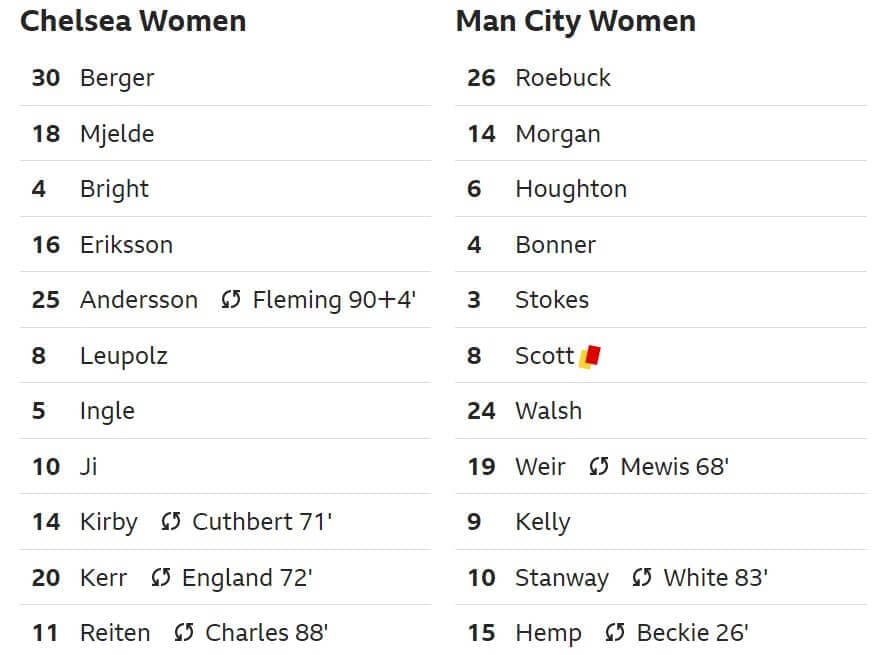
Both teams chose a 4-3-3 formation for this game. Chelsea Women started with Ann-Katrin Berger in goal; their regular back four of Maren Mjelde, Millie Bright, Magdalena Eriksson and Jonna Andersson; instead of a midfield diamond, they had new signing Melanie Leupolz, Sophie Ingle and Ji So-Yun forming a midfield three, whilst Fran Kirby, back from injury, and Guro Reiten played either side of striker Sam Kerr.
Manchester City Women, meanwhile, started with Ellie Roebuck in goal. 19-year-old Esme Morgan, who was on loan at Everton Women last season, played at right-back, with England captain Steph Houghton, Gemma Bonner and Demi Stokes joining her in defence. The midfield three consisted of Jill Scott, Keira Walsh and Caroline Weir, with the attack consisting of new signing and former Everton striker Chloe Kelly on the right, Lauren Hemp on the left, and midfielder Georgia Stanway in a “false nine” role through the middle.
Chelsea Women’s defence
We will begin by analysing Chelsea Women’s early defensive setup. In this image, we can see how they subdued Manchester City Women’s attacking players, preventing them creating opportunities.
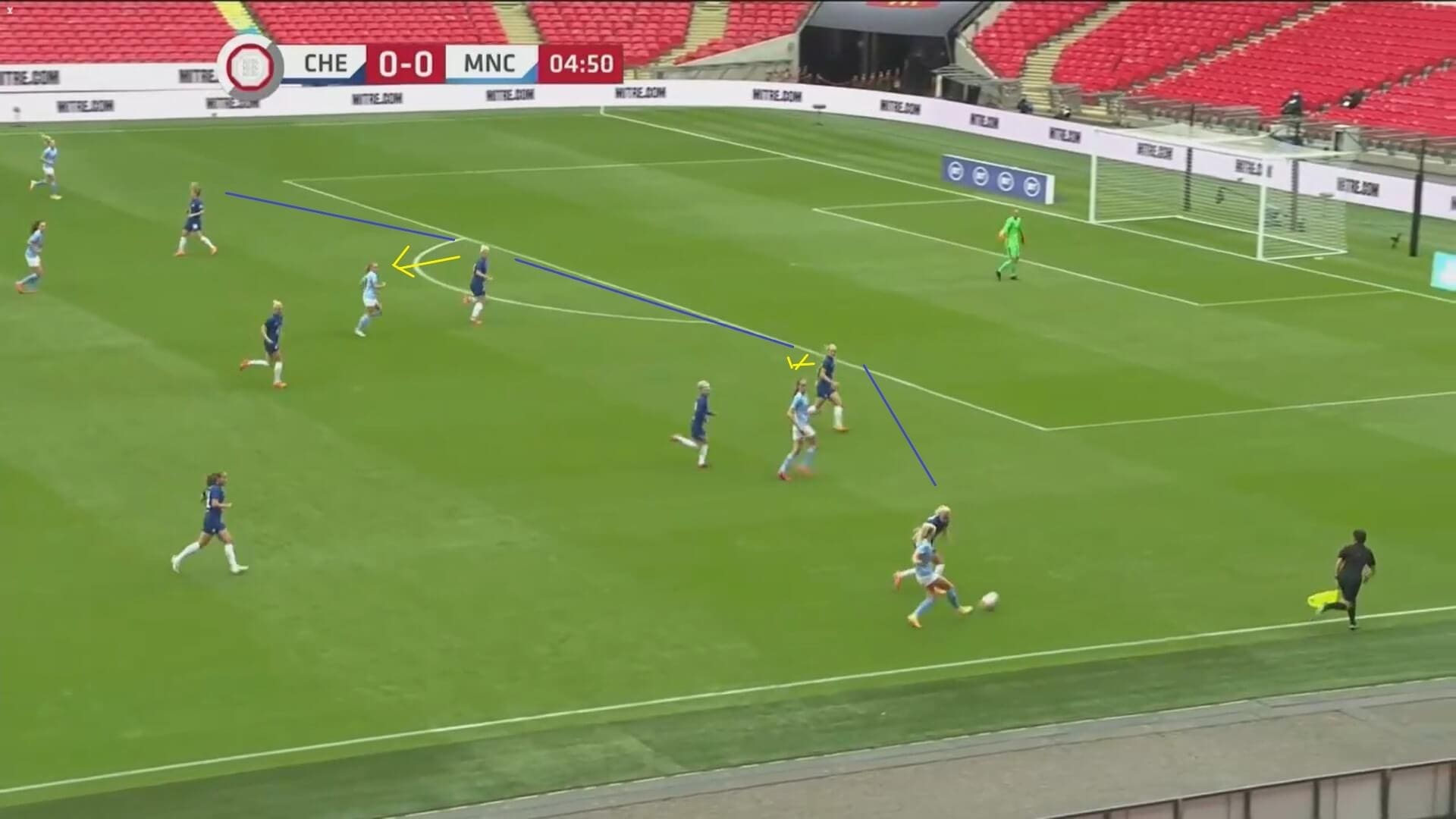
Here, you can see how Chelsea have spread across the pitch, making attacking difficult for Manchester City. Whilst there are gaps in the defensive line, Manchester City can’t get through them, as Chelsea are matching the attackers’ positions. On the near side of the pitch, the ball has been closed down, whilst both centre backs are marking the central attackers. Chloe Kelly, who is in possession, has passed forwards, but it is harmless because of Chelsea’s structure. Even if Manchester City were able to get to the ball, there wouldn’t be any way for them to cross it in, as Chelsea would have the advantage in getting to the ball first.
Therefore, what this shows is that Chelsea’s defenders know their defensive roles. If we look at the next image, we can see how they continue to be disciplined and work together at the back.
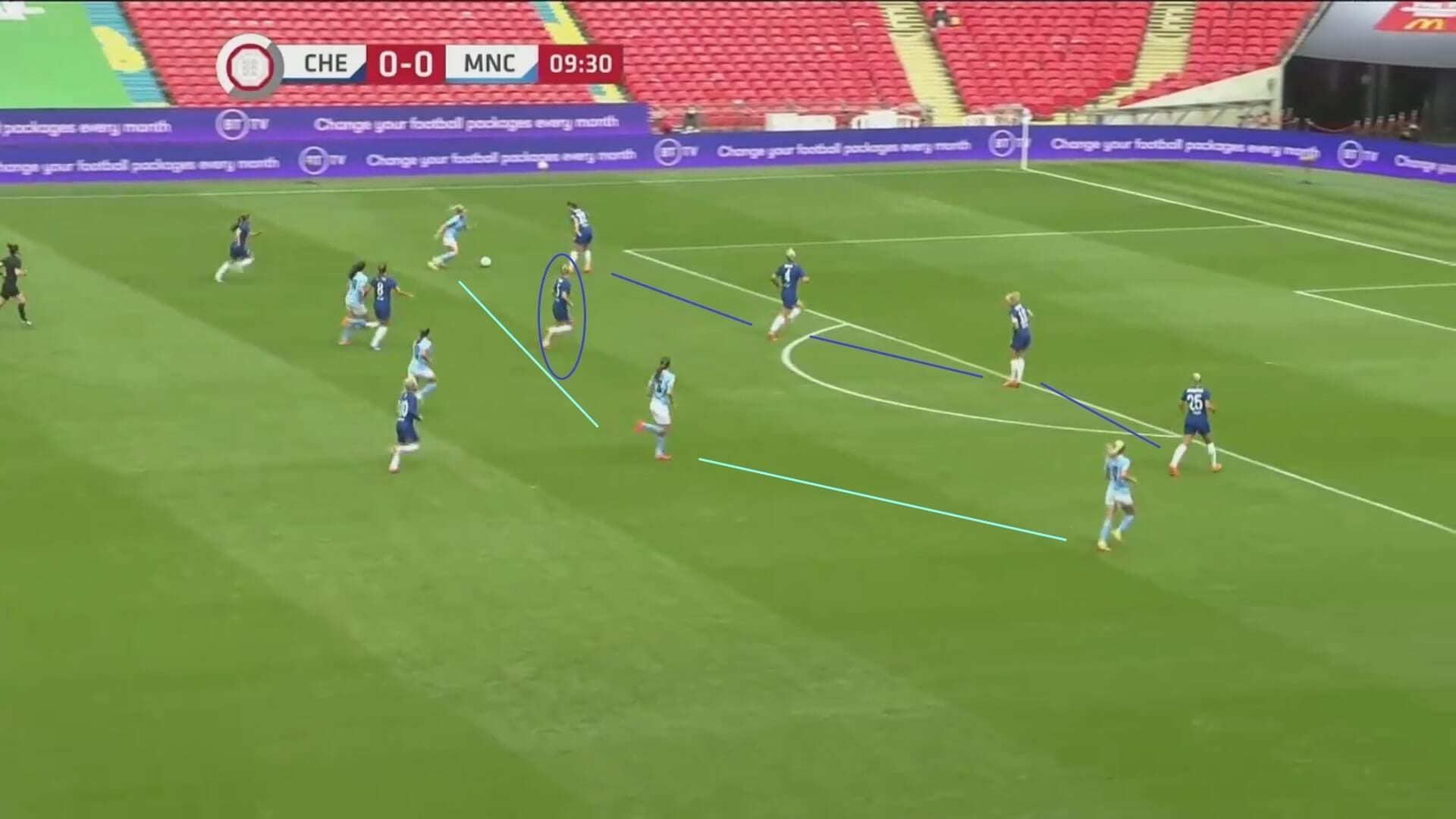
This time, they have become more narrow, matching Manchester City’s attack. Therefore, Chelsea can adapt their setup depending on their opponents’ structure. The other thing is that Wales midfielder Sophie Ingle has dropped back to sit in front of the defence, adding extra strength, and this is a regular feature of her game. Therefore, Manchester City find it very hard to attack here.
Chelsea Women’s attack
We have now seen how Chelsea set up defensively in the early stages of the game, and how they frustrated Manchester City’s attacking attempts. Now, we will turn our attention to their attack.
This section shows the difference between their first and second half attacking structures.
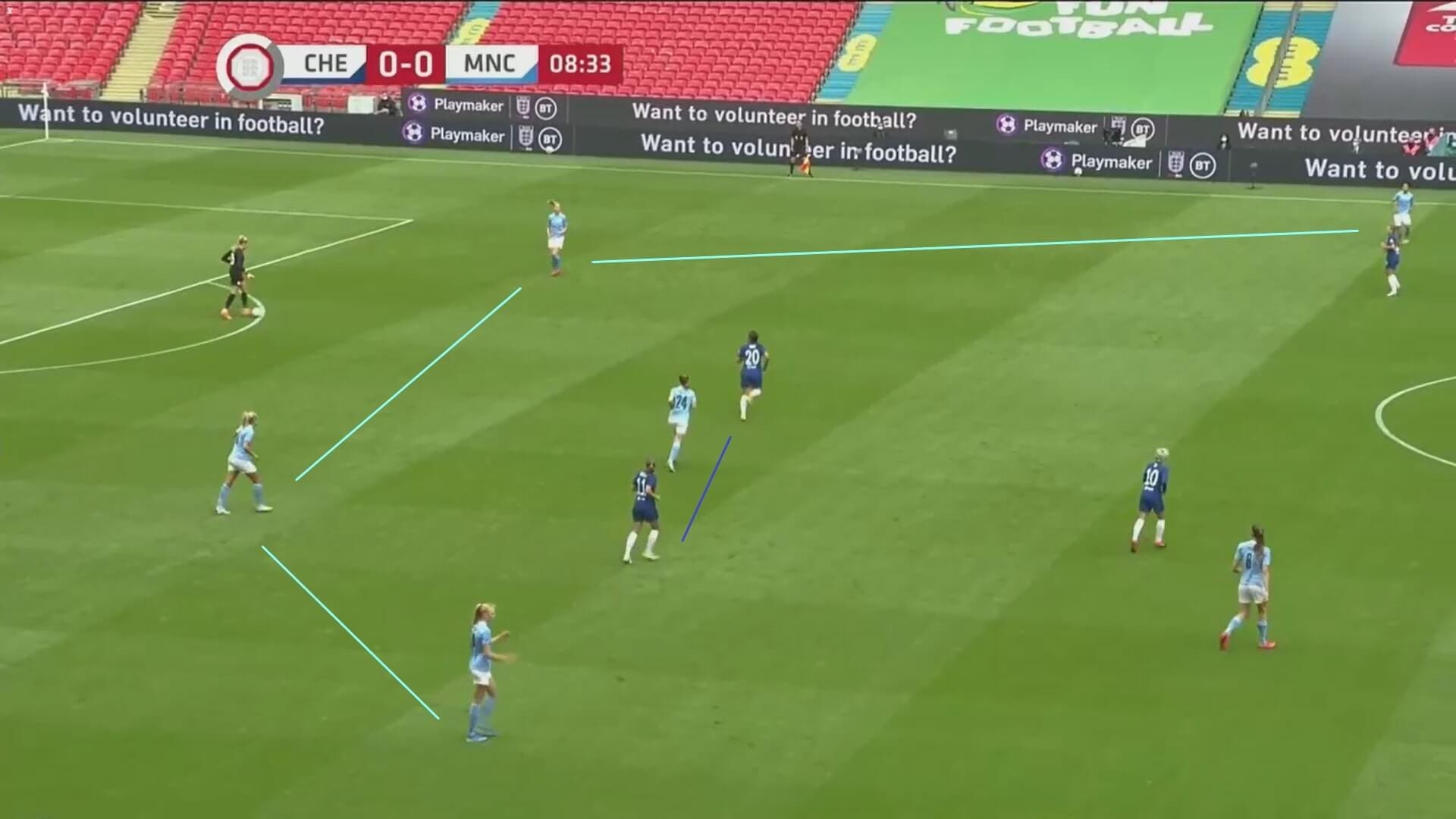
In the first half, we can see how Chelsea Women have a narrow attacking line, made up of Sam Kerr and Guro Reiten. Both players are close together, making it easy to both close them down and to play the ball around them. Manchester City’s defence is positioned across the pitch, giving them a clear advantage in this situation. This was one of the main reasons why Chelsea struggled in attack in the first half.
However, halfway through the second half, Chelsea manager Emma Hayes brought on Scotland forward Erin Cuthbert and last season’s top scorer Beth England for Kirby and Kerr, and you can see the difference this made below.
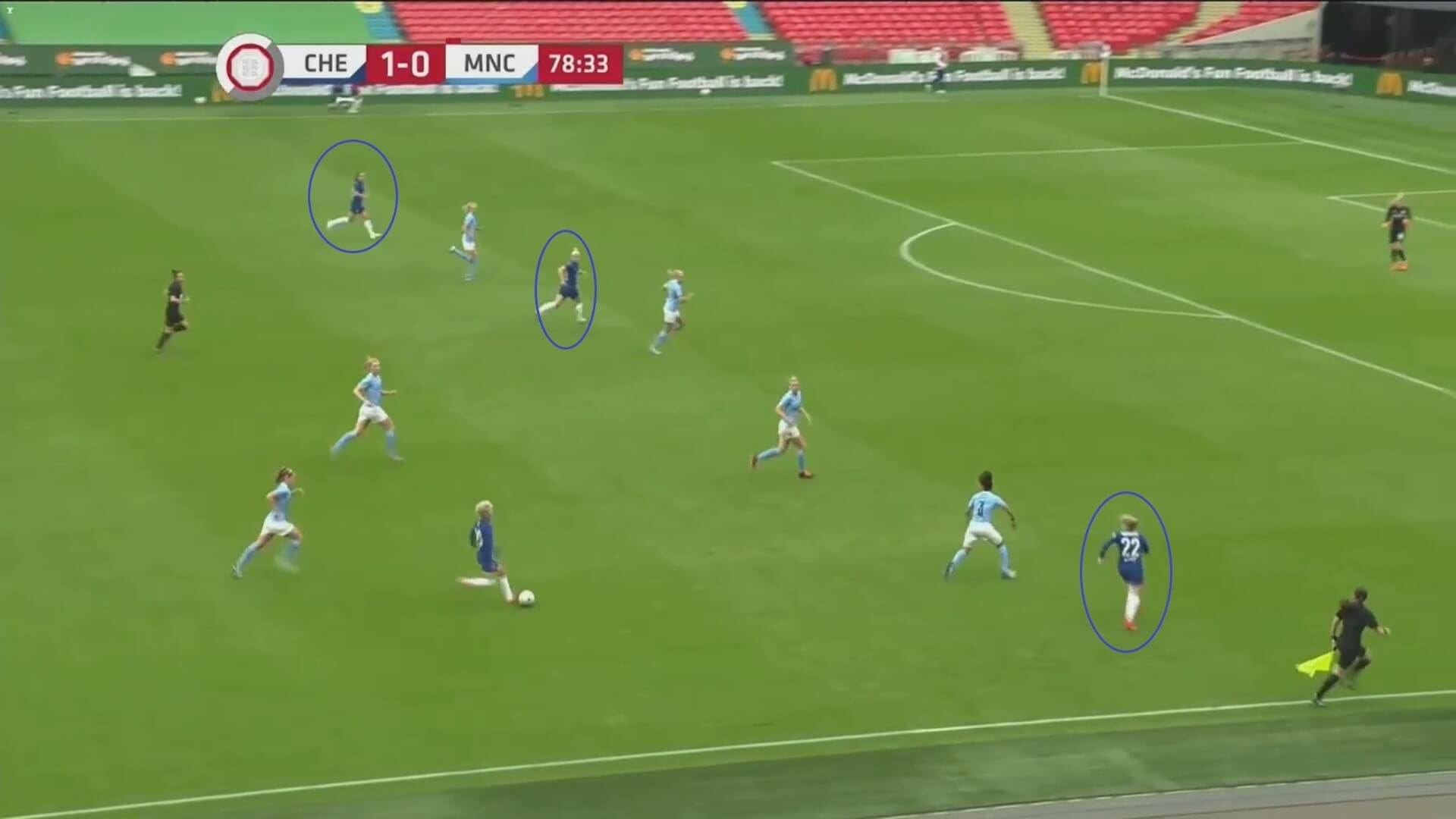
They now have a wider attacking structure, playing on the outside of Manchester City Women’s defence. The defensive line has not narrowed too much, but Chelsea have moved to play around it instead of in front of it. As a result, they can now play through the gaps of the defensive line, and Ji So-Yun is behind the attack, looking to play the ball through to Cuthbert, who is on the near side of the pitch.
Essentially, we have now set up how Chelsea defended well in the early stages and changed their attack to play with a wider structure. This change was one of the reasons why Chelsea came through as winners at the end of the match.
Sam Kerr v Beth England
The main reason why Chelsea Women struggled in the first half though was because of Sam Kerr’s positioning on the field. Last season, Chelsea used a midfield diamond and had both Beth England and Sam Kerr playing together as a front two pairing. However, the signs are that Emma Hayes wants to use a front three this season, and this would mean only one out of the two will start. Kerr was given the nod for this one, but she didn’t seem too comfortable in this position.
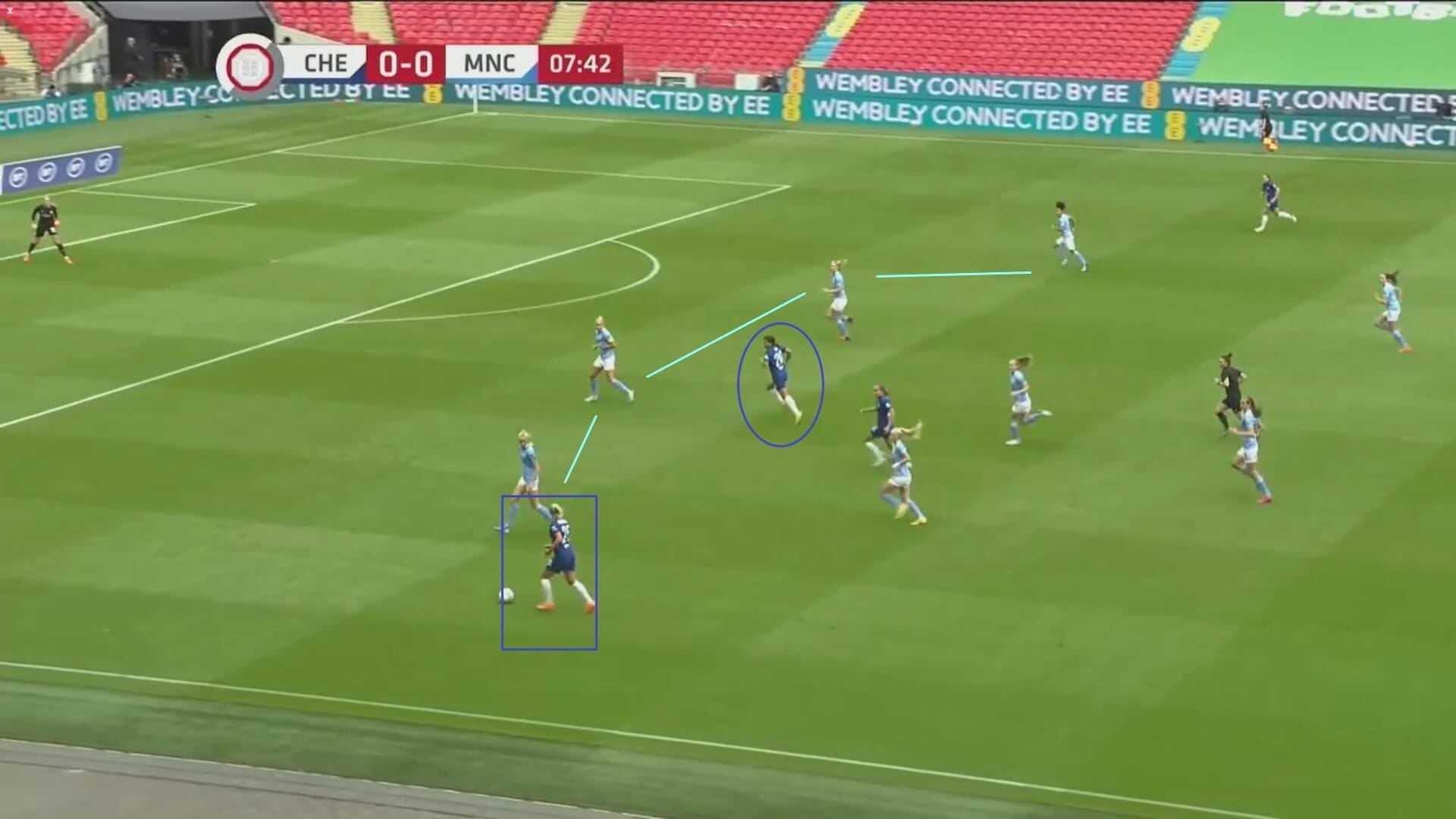
Here, we can see how Kerr is attacking but is in front of the Manchester City Women defence. This means that it’s easy for Manchester City to defend against Chelsea because they are not posing any threat to the space behind them. This is where Kerr needed to be looking to run behind the line, with Sweden left-back Jonna Andersson wanting to play the ball behind to set up a goalscoring opportunity. However, with Kerr where she is, the only option is to play the ball into the area in front of the defence.
As the match went on, Kerr did seem to offer more as a central striker.
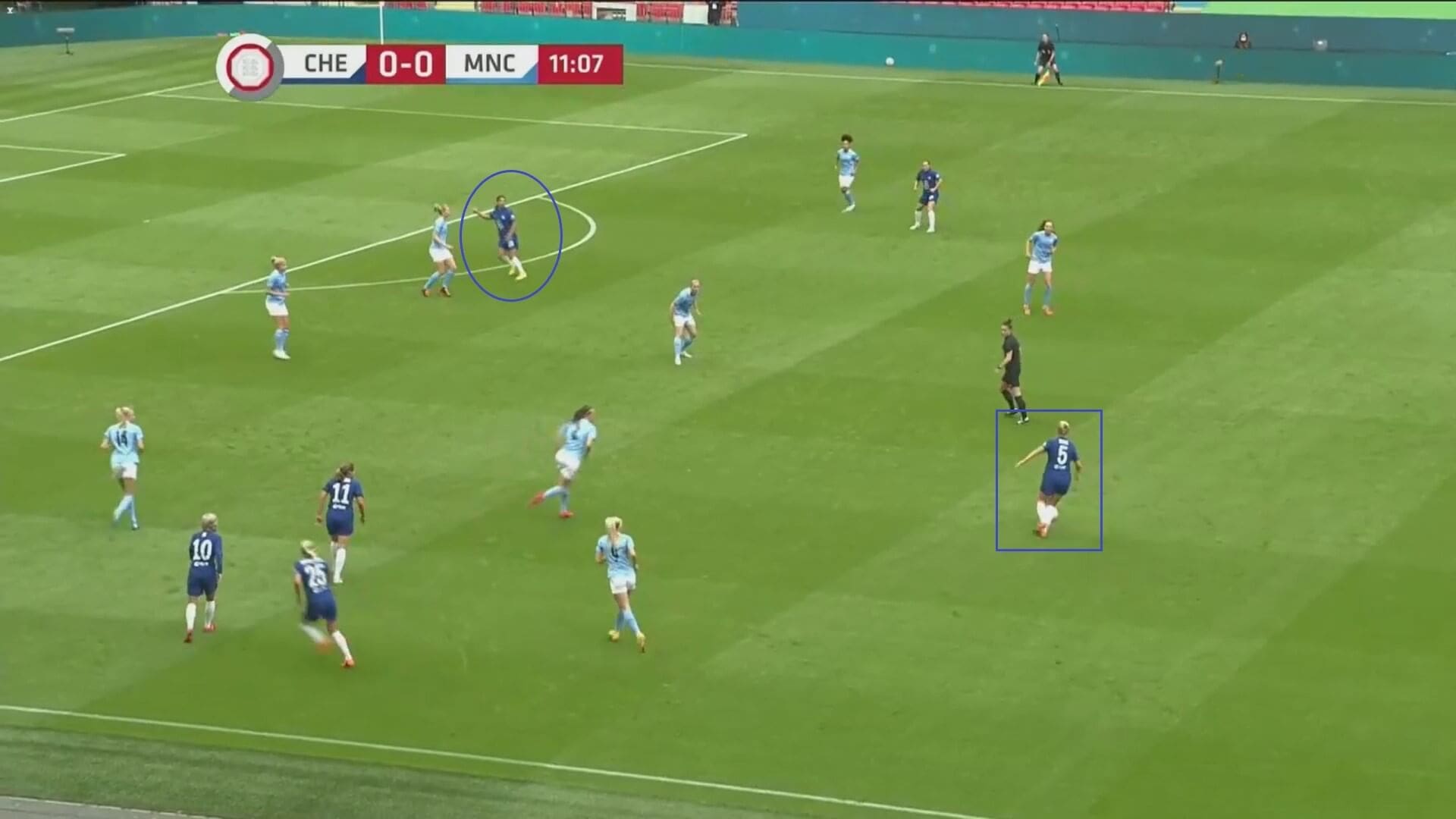
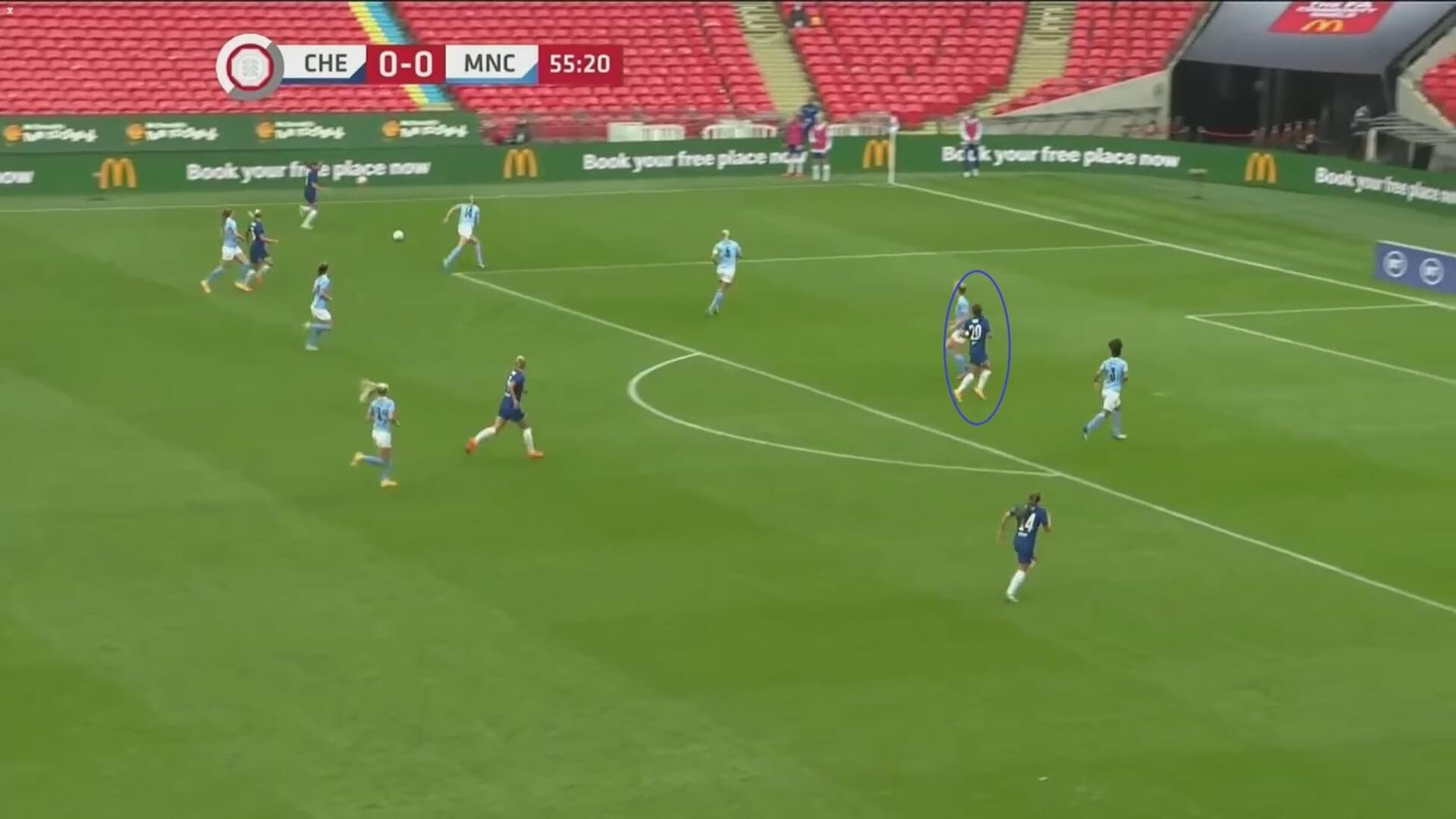
These images show Kerr in the first and second half. The first image comes just four minutes after we saw her playing in front of the defence, and you can already see the difference. Sophie Ingle, in the blue square, has the ball, and Kerr is in line with the Manchester City defence, pointing to where she wants the ball to go. Therefore, it’s clear that she has gained confidence much more.
In the second image, she is again offering a passing option to her teammate. This time, the ball is on the far side, but Kerr is between the two central defenders, making it more tricky for Manchester City to defend against her. You can see how they now have to backtrack with Kerr, stopping her from getting behind them; this opens up the space in front of those defenders for the ball to be crossed into.
What we can see from these images is that Sam Kerr seems to prefer playing in a front two formation, like we saw last season. The next thing she needs to add is a goal, as, despite three or four very good chances, she ended up with no goals to her name.
When she was replaced by Beth England, who is a more natural number nine, Chelsea posed a greater threat in attack.
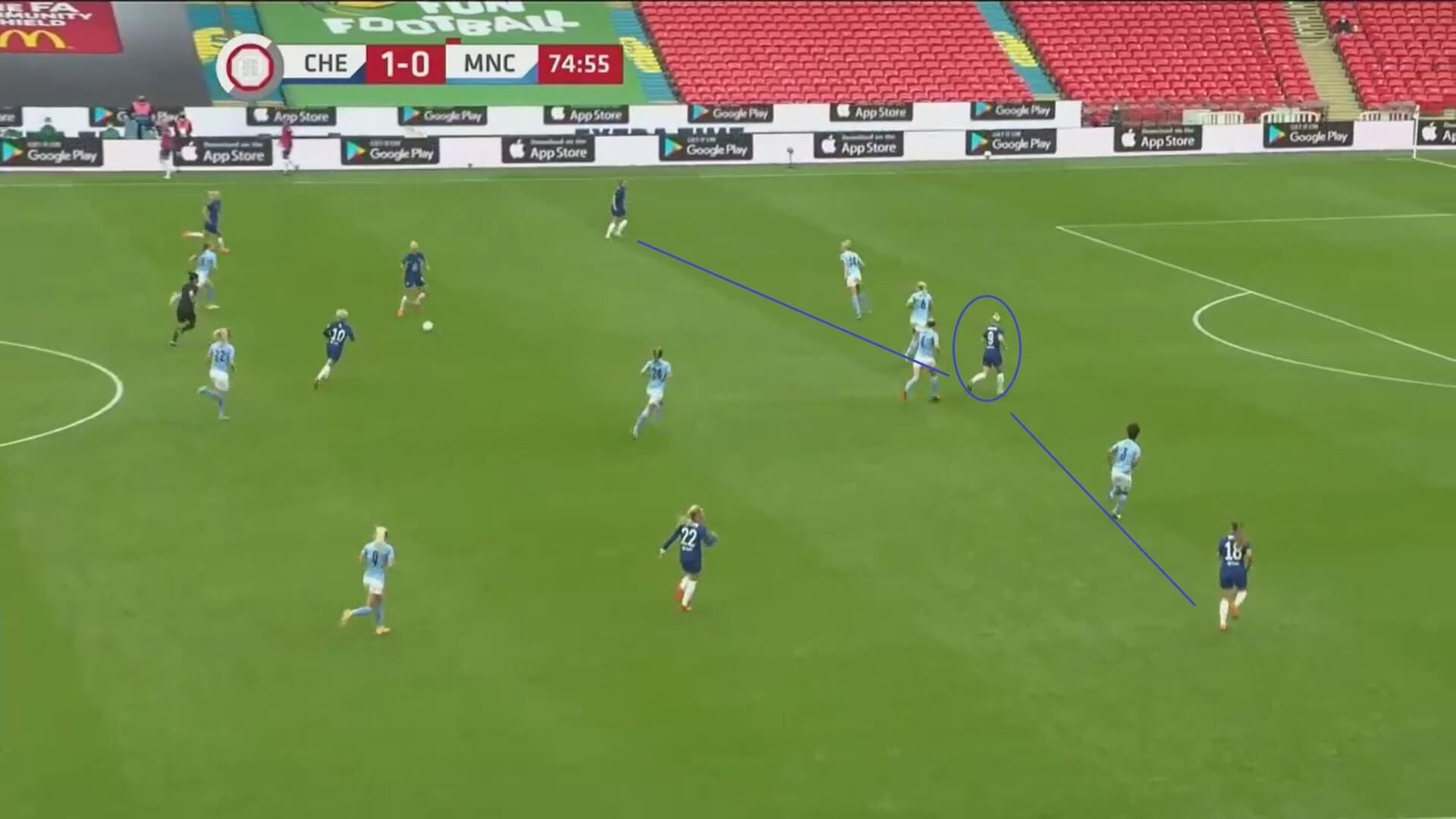
Here, we can see how they have moved beyond Manchester City’s defensive line, giving them the advantage in this area. If we compare this to the images before, then we can see what effect England’s introduction had on Chelsea’s attack. Manchester City have narrowed in their defensive structure, so this also helped to give Chelsea the advantage.
If there is to be a battle between England and Kerr for the central striking position, then it seems that England is the better player in the role. Kerr would be better used in a front two formation, like last season, or maybe as a winger with freedom to cut inside and shoot at goal in a front three like in this game. She did get better as the game went on, and learnt the role. However, as the season goes on, Chelsea will need a player who can get behind the opposing defence in tougher games, as it could be the difference between winning the match and not scoring in it.
Manchester City Women’s attack
We have spent a long time analysing Chelsea Women’s play in this game; now we turn our attention to Manchester City Women’s attack, looking at why they were unable to score in this game, despite also playing with a front three.
They started with Georgia Stanway as their central striker, but she is more of a winger or an attacking midfielder. This is the common problem that we will highlight in this section.
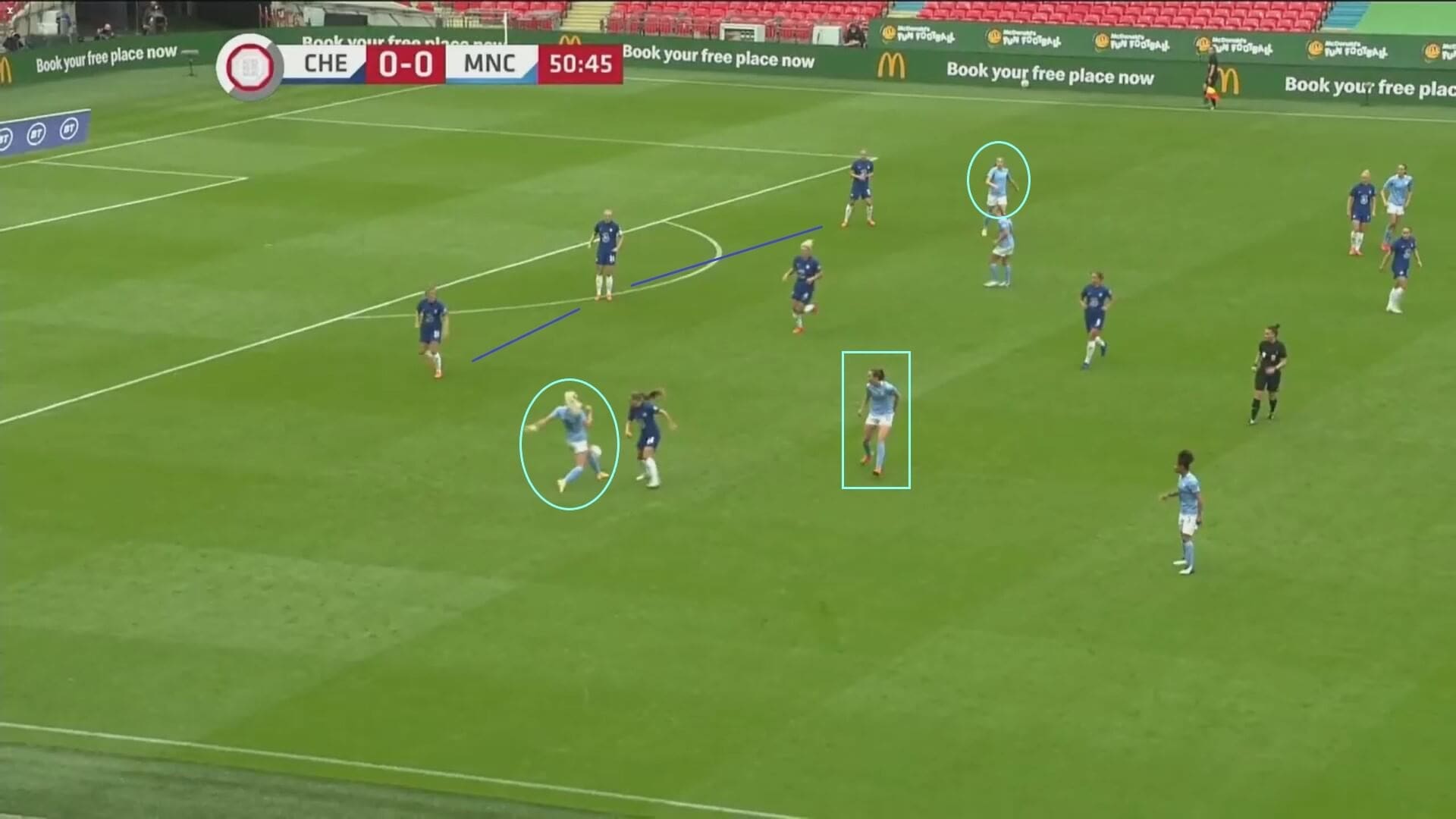
Here, we can see how Manchester City’s attack was unable to get going. They have their two wide players either side of the Chelsea defence, but Stanway is behind those players, meaning that Manchester City don’t have a central threat in this situation, and making it easy for Chelsea to defend against them. This is in the second half, but it was the case in the first half too. Ultimately, this is what can happen when a midfield or wide player is asked to play in the centre forward role, and it isn’t their regular position.
Like Sam Kerr, Stanway did grow into the role, as we can see below.
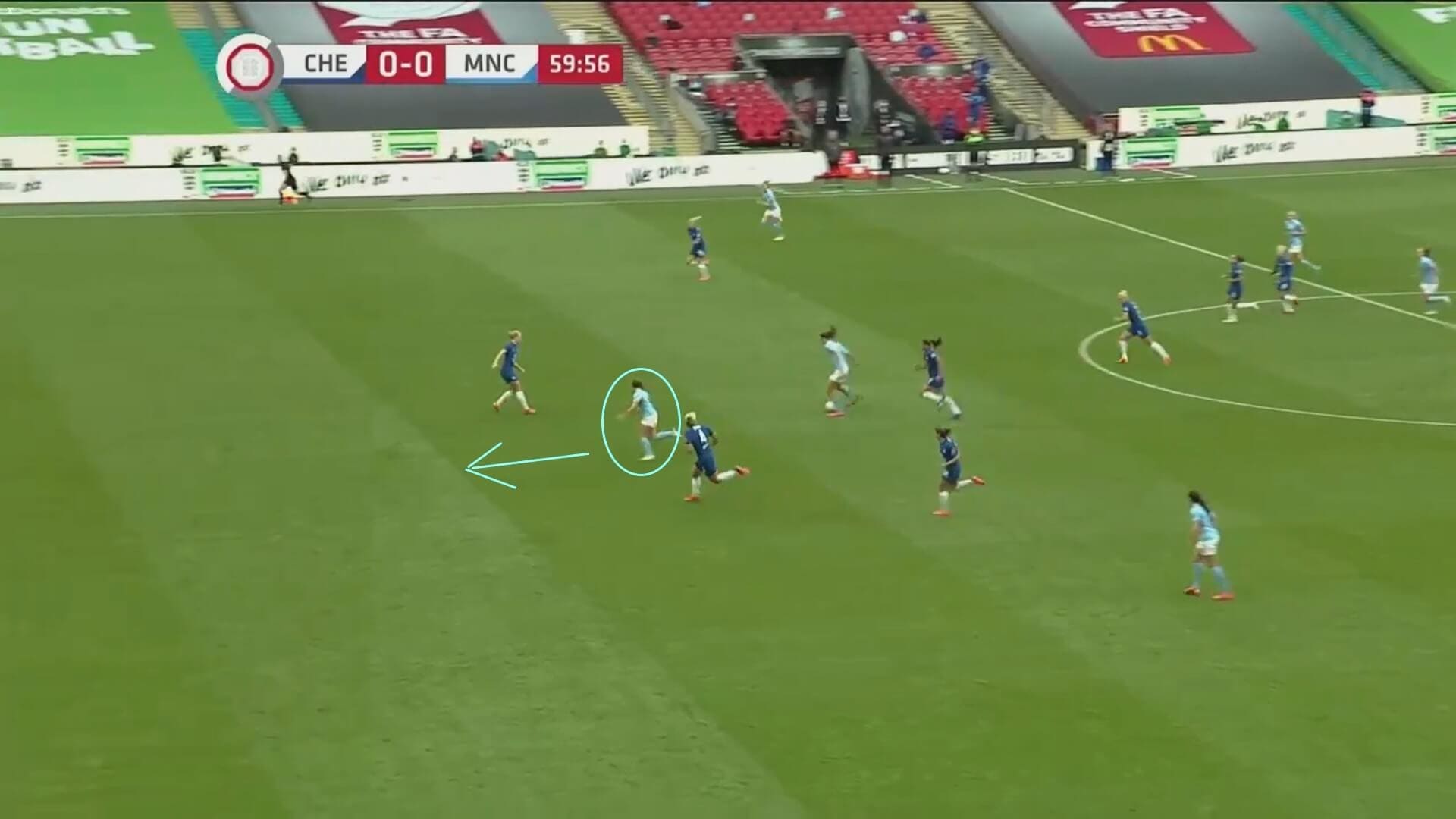
However, the question remains as to why Chelsea got players behind and managed to win the game, and why Manchester City did the same and didn’t. The answer is that Chelsea attacked with three players, and in a wide formation, whilst Manchester City only pushed one player forward.
You can see in this image how Stanway has moved between the two Chelsea defenders. Whilst this forces them to move backwards to stop her becoming a good passing option, Stanway has no support on either side from her teammates, and therefore Manchester City can’t take advantage of this attacking move. They have almost changed into a 4-2-3-1 here, which means that Stanway will find herself alone against four Chelsea defenders, making it almost impossible for her to get past them.
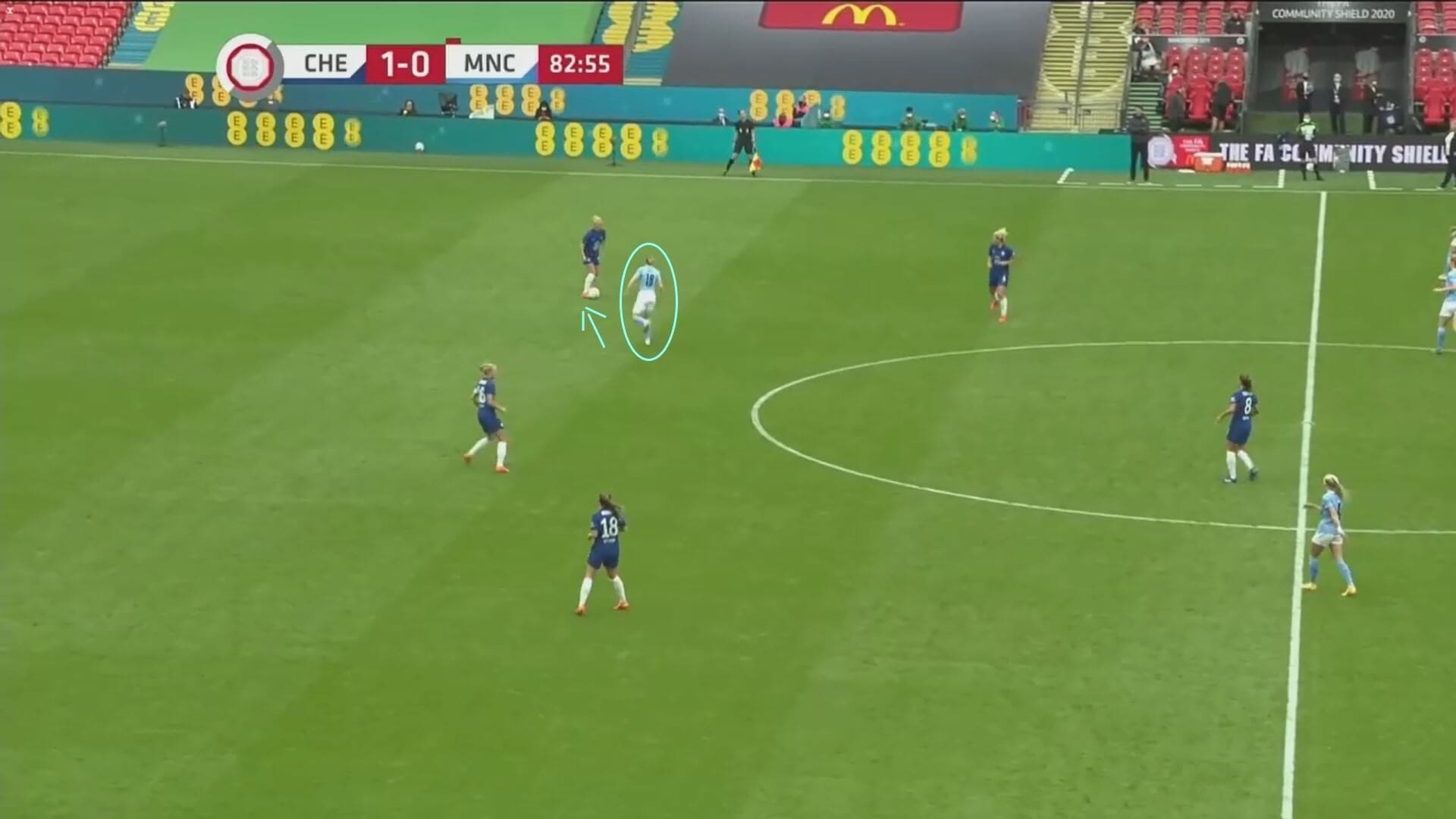
When Stanway was substituted for Ellen White, Manchester City Women had a striker on the pitch and someone who knows that role. Immediately, as you can see, White went chasing after the Chelsea defenders, meaning they had less time on the ball than they had had in the rest of the match. This meant that Chelsea couldn’t always play the ball forwards from these areas, sometimes having to play it sideways or backwards, and this was what Manchester City had been missing in their attack.
However, yet again, White is alone in chasing down the ball, and this was the main flaw in Manchester City’s attacking tactics. If White did get the ball, then she would have no teammates to pass the ball too, just like Stanway wouldn’t have, and the attack would have likely broken down very quickly. This was the reason that Chelsea were able to score, and Manchester City weren’t.
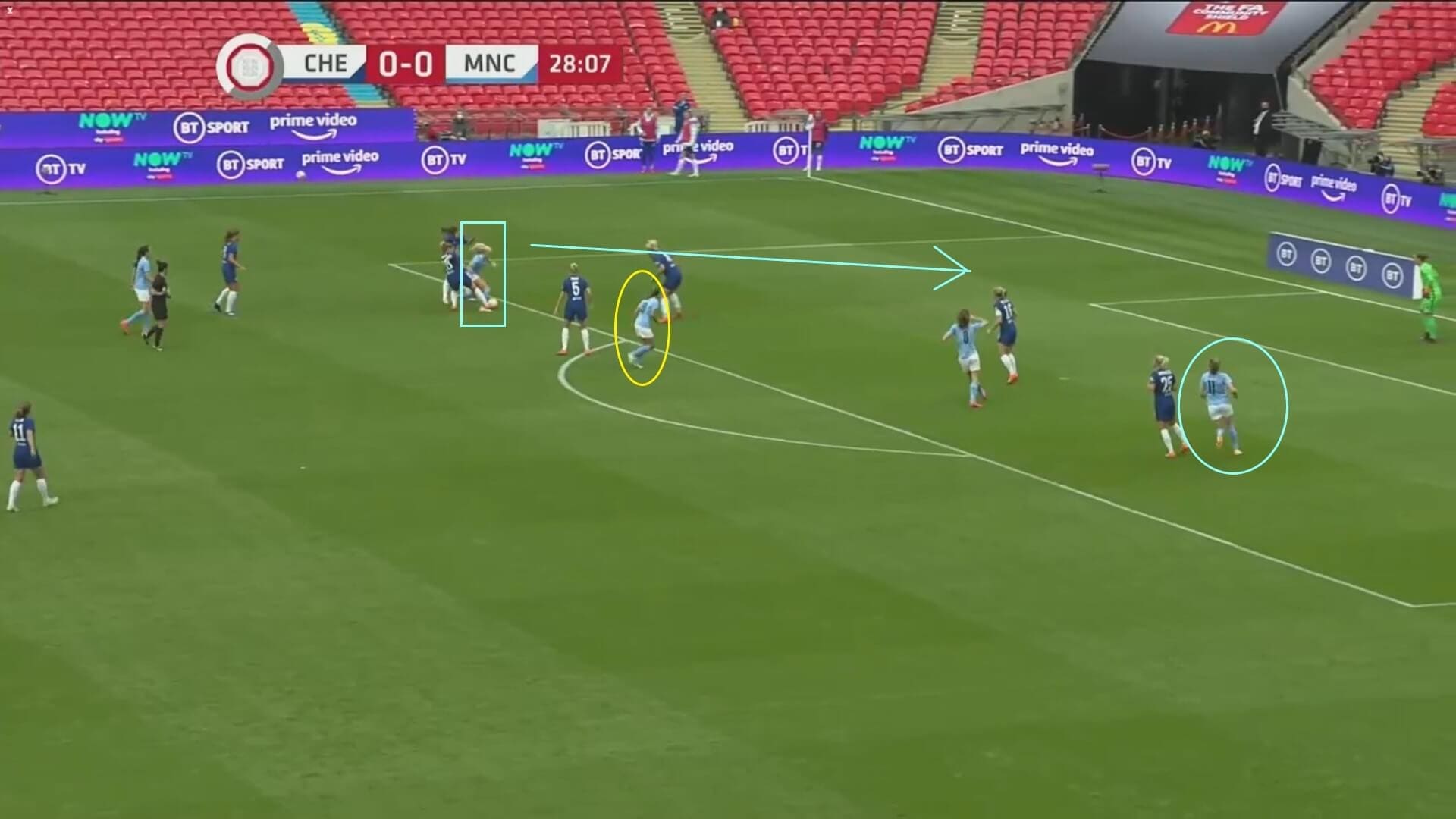
The final thing to mention about Manchester City Women’s attacking failings is that there was a noticeable change in pace once Canada forward Janine Beckie had come on. She replaced Lauren Hemp after just half an hour, with the England forward suffering a hamstring injury, but when she came on, Chloe Kelly moved over to the left-wing. This seemed to make a difference to their attack, as they had more pace on the wings after this switch.
In this image, Kelly weaves her way into the box and plays the ball across goal for Beckie to tap in. Although it was offside and didn’t count, this showed us that, whilst Lauren Hemp is a good player, Beckie and Kelly are perhaps the better options for wide strikers, because of the pace that both bring to the team. When on the right-hand side, Kelly didn’t look too comfortable and wasn’t able to show why Manchester City Women signed her this summer. However, the left side seems to be her better position in a front three setup, as we can see here. Beckie is a player who we know has pace and can get behind the defence, and, in this image, she has done just that, and is ready to get on the end of any pass that Kelly makes.
Therefore, what we can take from this section of the tactical analysis is that Manchester City’s team selection meant they struggled early on. However, a forced change and the second half addition of Ellen White ensured they carried more of a threat, but they need to improve the front line’s togetherness in order to take advantage of attacking situations much more.
Sam Mewis
The final thing we will look at briefly is USA international Sam Mewis’ performance, as she made her debut off the bench in this game, having moved from NWSL side North Carolina Courage this summer.
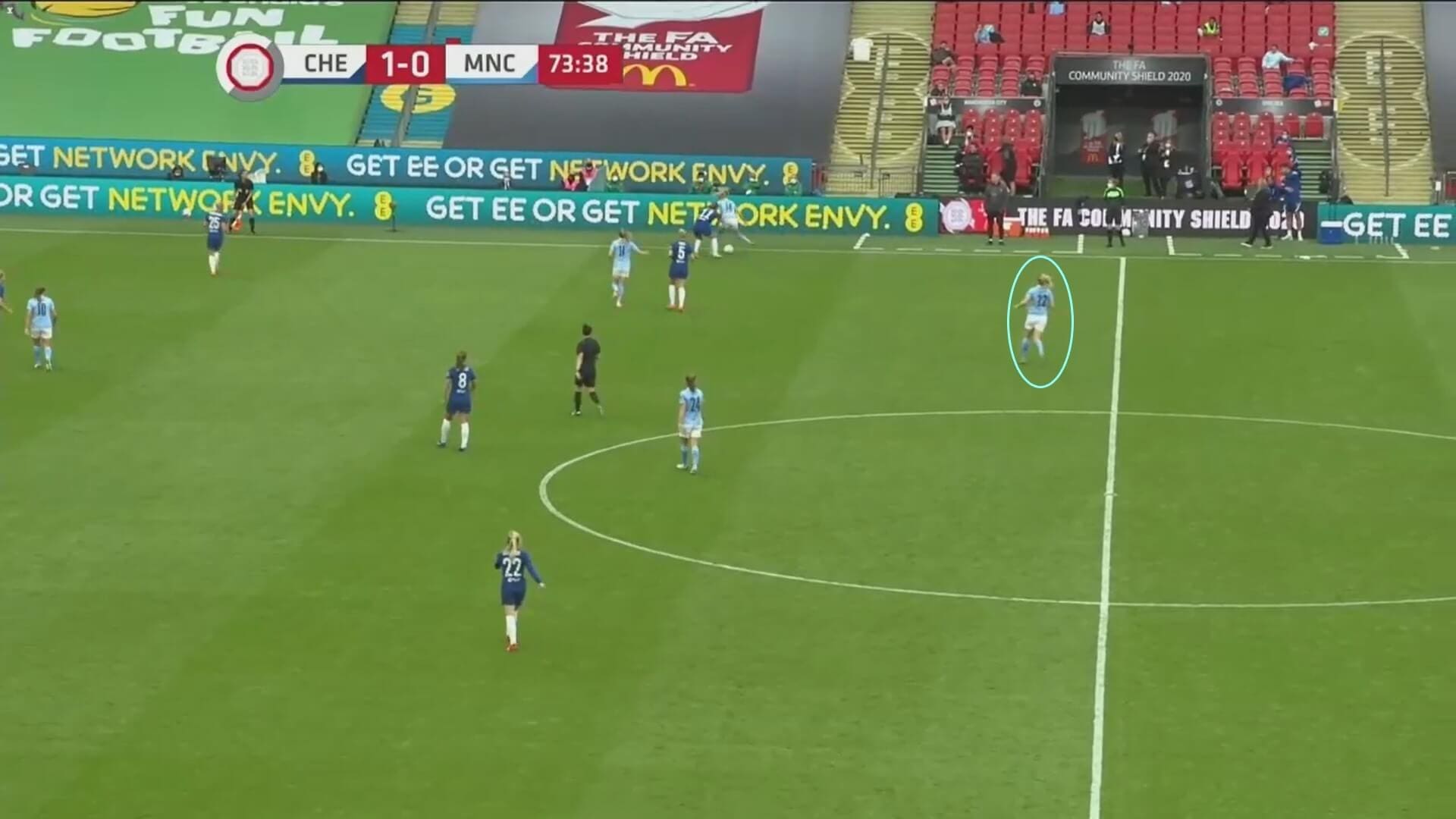
This image tells us that Mewis is likely to be used in a more defensive role, which means that other midfield players can push further forward, looking to increase Manchester City’s attacking presence. This was perhaps something that they needed in the first half, as it would have forced Chelsea to rethink their structure to try and contain them. However, with Jill Scott sent off for two yellow cards in this game, Mewis’ addition to the field helped to fill that space, but also got Manchester City going forward more often.
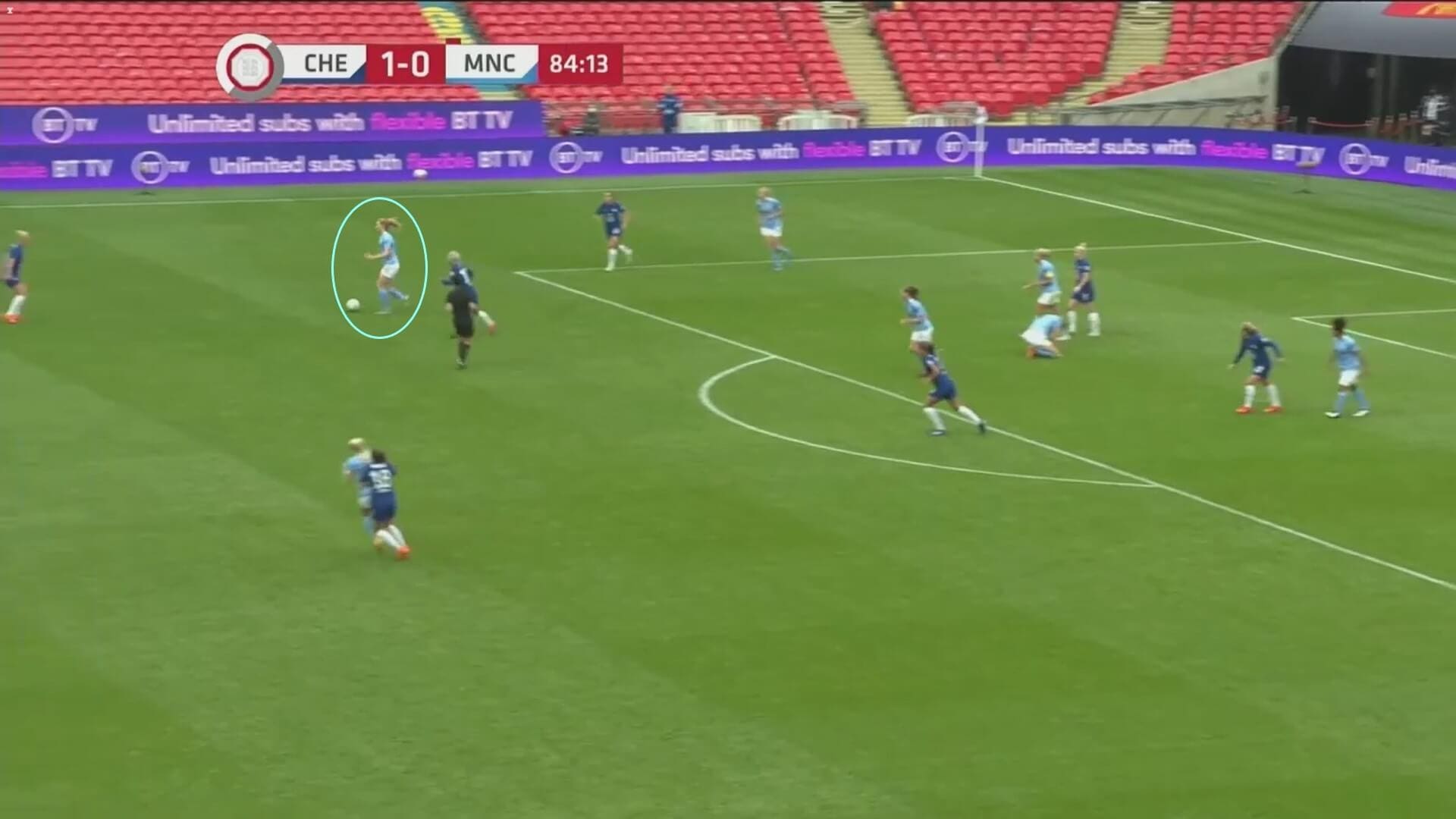
In this image, we see another thing that Mewis has seemingly added to Manchester City; a link between the defence and attack. In this situation, she has made an interception in her own box, having sat in front of the defence and waited for the opportunity to pounce, and is now preparing to play a long pass up the field and into the attack. This ability to offer protection to the defence, and then set attacking moves going in the other half of the pitch, is something that Manchester City will need this season, especially as playing long balls is a major feature of their game. Therefore, having a player like Mewis could help them to take the WSL title away from Chelsea Women this season.
Conclusion
In conclusion, this match, as well as providing us with a very good game to open the new season with, also gave us a flavour of how both Chelsea Women and Manchester City Women could set up and play this season. Both have made additions to their teams over the break, but the result came down to Chelsea attacking as a team and scoring, and Manchester City attacking with one player and not scoring. Both teams will have things to work on, but both managers will also be happy with elements of their team’s play too.





Comments